Full-Cycle Evaluation of Multi-Source Precipitation Products for Hydrological Applications in the Magat River Basin, Philippines
Abstract
Highlights
- Developed an integrated framework with bias correction and multi-criteria ranking.
- Nine SPPs showed distinct seasonal strengths in the Magat River Basin, Philippines.
- Corrected SPPs improve flood forecasting, drought monitoring, and water balance.
- Provides a replicable method for data-scarce, localized, and ungauged basins.
Abstract
1. Introduction
2. Materials and Methods
2.1. Study Area
2.2. Data Sources
2.3. Evaluation Metrics
2.4. Multi-Criteria Decision Analysis (EWM-TOPSIS)
2.5. Bias Correction Using Quantile Mapping
2.6. Post-Correction Re-Ranking and Decision Support
3. Results
3.1. Comparison of SPPs and Rain Gauge Observations
3.2. Performance of SPPs Based on Metrics
3.2.1. Statistical Accuracy and Detection Skills
3.2.2. Bias and Volume Accuracy
3.2.3. Erosive Precipitation Characteristics
3.3. Pre-Ranking Using EWM-TOPSIS Analysis
3.4. Bias Correction Impact Assessment
3.5. Post-Correction Suitability Analysis for the Best SPP
4. Discussion
5. Conclusions
Author Contributions
Funding
Data Availability Statement
Acknowledgments
Conflicts of Interest
Abbreviations
| SPP | Satellite Precipitation Product |
| PP | Precipitation Products |
| IMERG | Integrated Multi-satellitE Retrievals for GPM |
| CHIRPS | Climate Hazards Group InfraRed Precipitation with Station Data |
| ClimGridPh-RR | Climate Grid Philippines Reanalysis, daily gridded rainfall dataset for the Philippines |
| APHRODITE | Asian Precipitation–Highly Resolved Observational Data Integration Towards Evaluation |
| ERA5 | ECMWF Reanalysis v5 |
| MSWEP | Multi-Source Weighted Ensemble Precipitation |
| SM2RAIN-ASCAT | Soil Moisture to Rain–Advanced Scatterometer |
| GSMaP | Global Satellite Mapping of Precipitation |
| PERSIANN-CDR | Precipitation Estimation from Remotely Sensed Information using Artificial Neural Networks–Climate Data Record |
| MRB | Magat River Basin |
| CRB | Cagayan River Basin |
| NIA-MARIIS | National Irrigation Administration–Magat River Integrated Irrigation System |
| PAGASA | Philippine Atmospheric, Geophysical and Astronomical Services Administration |
| QM | Quantile Mapping |
| MCDA | Multi-Criteria Decision Analysis |
| NSE | Nash-Sutcliffe Efficiency |
| RMSE | Root Mean Square Error |
| MAE | Mean Absolute Error |
| R2 | Correlation Coefficient |
| RB | Relative Bias |
| VR | Volume Ratio |
| SORS | Sum of Residuals |
| POD | Probability of Detection |
| FAR | False Alarm Ratio |
| CSI | Critical Success Index |
| ARI | Average Rainfall Intensity |
| NRDY | Number of Rainy Days in a Year |
| NHRD | Number of Heavy Rain Days |
| MDR | Maximum Daily Rainfall |
| EWM | Entropy Weight Method |
| TOPSIS | Technique for Order of Preference by Similarity to Ideal Solution |
| LGU | Local Government Unit |
| LOCI | Local Intensity Scaling |
| masl | Meters Above Sea Level |
| ECMWF | European Centre for Medium-Range Weather Forecasts |
References
- Maggioni, V.; Meyers, P.C.; Robinson, M.D. A Review of Merged High-Resolution Satellite Precipitation Product Accuracy during the Tropical Rainfall Measuring Mission (TRMM) Era. J. Hydrometeorol. 2016, 17, 1101–1117. [Google Scholar] [CrossRef]
- He, R.; Li, H.; Luo, J.; Huang, H.; Zhu, Y. Comparison of the Reflectivities from Precipitation Measurement Radar Onboard the FY-3G Satellite and Ground-Based S-Band Dual-Polarization Radars. Remote Sens. 2025, 17, 1117. [Google Scholar] [CrossRef]
- Benkirane, M.; Amazirh, A.; Laftouhi, N.E.; Khabba, S.; Chehbouni, A. Assessment of GPM Satellite Precipitation Performance after Bias Correction, for Hydrological Modeling in a Semi-Arid Watershed (High Atlas Mountain, Morocco). Atmosphere 2023, 14, 794. [Google Scholar] [CrossRef]
- Vázquez-Rodríguez, D.A.; Guerra-Cobián, V.H.; Bruster-Flores, J.L.; Fonseca, C.R.; Yépez-Rincón, F.D. Evaluating the Performance and Applicability of Satellite Precipitation Products over the Rio Grande–San Juan Basin in Northeast Mexico. Atmosphere 2024, 15, 749. [Google Scholar] [CrossRef]
- Andari, R.; Nurhamidah, N.; Daoed, D. Marzuki Evaluation of Bias Correction Methods for Multi-Satellite Rainfall Estimation Products. IOP Conf. Ser. Earth Environ. Sci. 2024, 1317, 012008. [Google Scholar] [CrossRef]
- Maidment, R.I.; Grimes, D.; Black, E.; Tarnavsky, E.; Young, M.; Greatrex, H.; Allan, R.P.; Stein, T.; Nkonde, E.; Senkunda, S.; et al. A New, Long-Term Daily Satellite-Based Rainfall Dataset for Operational Monitoring in Africa. Sci. Data 2017, 4, 170063. [Google Scholar] [CrossRef]
- Kabite Wedajo, G.; Kebede Muleta, M.; Gessesse Awoke, B. Performance Evaluation of Multiple Satellite Rainfall Products for Dhidhessa River Basin (DRB), Ethiopia. Atmos. Meas. Tech. 2021, 14, 2299–2316. [Google Scholar] [CrossRef]
- Nair, S.; Srinivasan, G.; Nemani, R. Evaluation of Multi-Satellite TRMM Derived Rainfall Estimates over a Western State of India. J. Meteorol. Soc. Jpn. 2009, 87, 927–939. [Google Scholar] [CrossRef]
- Ramos, M.D.; Tendencia, E.; Espana, K.; Sabido, J.; Bagtasa, G. Assessment of Satellite Precipitation Products in the Philippine Archipelago. In Proceedings of the The International Archives of the Photogrammetry, Remote Sensing and Spatial Information Sciences, 2016 XXIII ISPRS Congress, Prague, Czech Republic, 12–19 July 2016; Volume XLI-B1, pp. 423–427. [Google Scholar] [CrossRef]
- de Moraes Cordeiro, A.L.; Blanco, C.J.C. Assessment of Satellite Products for Filling Rainfall Data Gaps in the Amazon Region. Nat. Resour. Model. 2021, 34, e12298. [Google Scholar] [CrossRef]
- Gado, T.A.; Zamzam, D.H.; Guo, Y.; Zeidan, B.A. Evaluation of Satellite-Based Rainfall Estimates in the Upper Blue Nile Basin. J. Earth Syst. Sci. 2024, 133, 27. [Google Scholar] [CrossRef]
- Aryastana, P.; Liu, C.Y.; Jong-Dao Jou, B.; Cayanan, E.; Punay, J.P.; Chen, Y.N. Assessment of Satellite Precipitation Data Sets for High Variability and Rapid Evolution of Typhoon Precipitation Events in the Philippines. Earth Space Sci. 2022, 9, e2022EA002382. [Google Scholar] [CrossRef]
- Sun, M.; Liu, A.; Zhao, L.; Wang, C.; Yang, Y. Evaluation of Multi-Source Precipitation Products in the Hinterland of the Tibetan Plateau. Atmosphere 2024, 15, 138. [Google Scholar] [CrossRef]
- Veloria, A.; Perez, G.J.; Tapang, G.; Comiso, J. Improved Rainfall Data in the Philippines through Concurrent Use of GPM IMERG and Ground-Based Measurements. Remote Sens. 2021, 13, 2859. [Google Scholar] [CrossRef]
- DOST-PAGASA. Combined In Situ and Satellite-Based Daily Rainfall Data of the Philippines in High-Resolution Grids; DOST-PAGASA: Quezon City, Philippines, 2024. [Google Scholar]
- Putra, M.; Rosid, M.S.; Handoko, D. A Review of Rainfall Estimation in Indonesia: Data Sources, Techniques, and Methods. Signals 2024, 5, 542–561. [Google Scholar] [CrossRef]
- Khan, F.S.; Hasany, N.; Abid, S.K.; Khurram, M.; Gacu, J.; Monjardin, C.E.; de Jesus, K.L. Machine Learning-Assisted Denoising of Raman Spectral Remote Sensing Data for Improved Land Use Mapping. Rev. Int. Géomat. 2025, 34, 415–432. [Google Scholar] [CrossRef]
- Perera, H.; Fernando, S.; Gunathilake, M.B.; Sirisena, T.A.J.G.; Rathnayake, U. Evaluation of Satellite Rainfall Products over the Mahaweli River Basin in Sri Lanka. Adv. Meteorol. 2022, 2022, 1926854. [Google Scholar] [CrossRef]
- Causse, A.; Planche, C.; Buisson, E.; Baray, J.L. Evaluation of Rain Estimates from Several Ground-Based Radar Networks and Satellite Products for Two Cases Observed over France in 2022. Atmosphere 2023, 14, 1726. [Google Scholar] [CrossRef]
- Chen, H.; Wen, D.; Du, Y.; Xiong, L.; Wang, L. Errors of Five Satellite Precipitation Products for Different Rainfall Intensities. Atmos. Res. 2023, 285, 106622. [Google Scholar] [CrossRef]
- Tran, T.N.D.; Le, M.H.; Zhang, R.; Nguyen, B.Q.; Bolten, J.D.; Lakshmi, V. Robustness of Gridded Precipitation Products for Vietnam Basins Using the Comprehensive Assessment Framework of Rainfall. Atmos. Res. 2023, 293, 106923. [Google Scholar] [CrossRef]
- Shalishe, A.; Berihu, T.; Arba, Y. Performance Evaluation of Multi-Satellite Rainfall Products for Analyzing Rainfall Variability in Abaya–Chamo Basin: Southern Ethiopia. J. Earth Syst. Sci. 2024, 133, 139. [Google Scholar] [CrossRef]
- Araujo Palharini, R.S.; Vila, D.A.; Rodrigues, D.T.; Palharini, R.C.; Mattos, E.V.; Pedra, G.U. Assessment of Extreme Rainfall Estimates from Satellite-Based: Regional Analysis. Remote Sens. Appl. Soc. Environ. 2021, 23, 100603. [Google Scholar] [CrossRef]
- Gowri, L.; Manjula, K.R.; Sasireka, K.; Deepa, D. Assessment of Statistical Models for Rainfall Forecasting Using Machine Learning Technique. J. Soft Comput. Civ. Eng. 2022, 6, 51–67. [Google Scholar] [CrossRef]
- Datti, A.D.; Zeng, G.; Tarnavsky, E.; Cornforth, R.; Pappenberger, F.; Abdullahi, B.A.; Onyejuruwa, A. Urban Peri-Urban Planning Impact. Remote Sens. 2024, 16, 1755. [Google Scholar] [CrossRef]
- Mashuri; Karlina; Sujono, J. Assessment of Satellite-Based Rainfall Products for Drought Monitoring in the Siak Watershed, Indonesia. Environ. Chall. 2025, 19, 101134. [Google Scholar] [CrossRef]
- da Silva Hucke, A.T.; Menegaz, M.N.; Isidoro, J.M.G.P.; de Oliveira Tiezzi, R. Assessment of Climate Change Impacts on Rainfall and Streamflow in the Alto Paranapanema Basin, Brazil. J. Water Clim. Change 2024, 15, 2110–2126. [Google Scholar] [CrossRef]
- Wodebo, D.Y.; Melesse, A.M.; Woldesenbet, T.A.; Mekonnen, K.; Amdihun, A.; Korecha, D.; Tedla, H.Z.; Corzo, G.; Teshome, A. Comprehensive Performance Evaluation of Satellite-Based and Reanalysis Rainfall Estimate Products in Ethiopia: For Drought, Flood, and Water Resources Applications. J. Hydrol. Reg. Stud. 2025, 57, 102150. [Google Scholar] [CrossRef]
- Omar, G.M.; Paturel, J.E.; Salles, C.; Mahé, G.; Jalludin, M.; Satgé, F.; Nour, M.I. Evaluation of Rainfall Products in Semi-Arid Areas: Application to the Southeast of the Republic of Djibouti and a Focus on the Ambouli Catchment. Water 2023, 15, 2168. [Google Scholar] [CrossRef]
- Nkunzimana, A.; Bi, S.; Alriah, M.A.A.; Zhi, T.; Kur, N.A.D. Comparative Analysis of the Performance of Satellite-Based Rainfall Products Over Various Topographical Unities in Central East Africa: Case of Burundi. Earth Space Sci. 2020, 7, e2019EA000834. [Google Scholar] [CrossRef]
- Dandridge, C.; Lakshmi, V.; Bolten, J.; Srinivasan, R. Evaluation of Satellite-Based Rainfall Estimates in the Lower Mekong River Basin (Southeast Asia). Remote Sens. 2019, 11, 2709. [Google Scholar] [CrossRef]
- Gebremicael, T.G.; Deitch, M.J.; Gancel, H.N.; Croteau, A.C.; Haile, G.G.; Beyene, A.N.; Kumar, L. Satellite-Based Rainfall Estimates Evaluation Using a Parsimonious Hydrological Model in the Complex Climate and Topography of the Nile River Catchments. Atmos. Res. 2022, 266, 105939. [Google Scholar] [CrossRef]
- Bonilla-López, E.; Lobato-Sánchez, R.; Medellin-Azuara, J.; Patiño-Gómez, C. Satellite Precipitation Assessment and Correction Technique Selection at Sub-Basin Scale for Maximum Annual Events. Case Study: Acaponeta River Basin. Atmósfera 2025, 75, 49–75. [Google Scholar] [CrossRef]
- Tan, M.L.; Ibrahim, A.L.; Duan, Z.; Cracknell, A.P.; Chaplot, V. Evaluation of Six High-Resolution Satellite and Ground-Based Precipitation Products over Malaysia. Remote Sens. 2015, 7, 1504–1528. [Google Scholar] [CrossRef]
- Kubota, T.; Ushio, T.; Shige, S.; Kida, S.; Kachi, M.; Okamoto, K. Verification of High-Resolution Satellite-Based Rainfall Estimates around Japan Using a Gauge-Calibrated Ground-Radar Dataset. J. Meteorol. Soc. Jpn. 2009, 87A, 203–222. [Google Scholar] [CrossRef]
- Jiang, Q.; Li, W.; Wen, J.; Fan, Z.; Chen, Y.; Scaioni, M.; Wang, J. Evaluation of Satellite-Based Products for Extreme Rainfall Estimations in the Eastern Coastal Areas of China. J. Integr. Environ. Sci. 2019, 16, 191–207. [Google Scholar] [CrossRef]
- Wei, Y. The Assessment of the Accuracy of Meteorological Satellite Rainfall Measurement Products in the Heihe River Basin. IOP Conf. Ser. Mater. Sci. Eng. 2018, 392, 062146. [Google Scholar] [CrossRef]
- Ceferino-Hernández, L.; Magaña-Hernández, F.; Campos-Campos, E.; Morosanu, G.A.; Torres-Aguilar, C.E.; Mora-Ortiz, R.S.; Díaz, S.A. Assessment of PERSIANN Satellite Products over the Tulijá River Basin, Mexico. Remote Sens. 2024, 16, 2596. [Google Scholar] [CrossRef]
- Bakary, F.; Abdou, A.; Honoré, D.; Ansoumana, B.; Salif, D.; Luc, D.; Bakary, F.; Abdou, A.; Honoré, D.; Ansoumana, B.; et al. Assessment of Satellite Rainfall Products for Stream Flow Simulation in Gambia Watershed. Afr. J. Environ. Sci. Technol. 2018, 12, 501–513. [Google Scholar] [CrossRef]
- Chen, H.; Yong, B.; Qi, W.; Wu, H.; Ren, L.; Hong, Y. Investigating the Evaluation Uncertainty for Satellite Precipitation Estimates Based on Two Different Ground Precipitation Observation Products. J. Hydrometeorol. 2020, 21, 2595–2606. [Google Scholar] [CrossRef]
- El Khalki, E.M.; Tramblay, Y.; Saidi, M.E.; Marchane, A.; Chehbouni, A. Hydrological Assessment of Different Satellite Precipitation Products in Semi-Arid Basins in Morocco. Front. Water 2023, 5, 1243251. [Google Scholar] [CrossRef]
- Hinge, G.; Hamouda, M.A.; Long, D.; Mohamed, M.M. Hydrologic Utility of Satellite Precipitation Products in Flood Prediction: A Meta-Data Analysis and Lessons Learnt. J. Hydrol. 2022, 612, 128103. [Google Scholar] [CrossRef]
- Hartmann, H. Comparison of Precipitation Rates from Global Datasets for the Five-Year Period from 2019 to 2023. Hydrology 2025, 12, 4. [Google Scholar] [CrossRef]
- Gacu, J.G.; Monjardin, C.E.F.; Mangulabnan, R.G.T.; Mendez, J.C.F. Application of Artificial Intelligence in Hydrological Modeling for Streamflow Prediction in Ungauged Watersheds: A Review. Water 2025, 5, 2722. [Google Scholar] [CrossRef]
- Pradhan, R.; Byrd, A.; Jourdan, M.R. Development of Predictive Relationships for Flood Hazard Assessments in Ungaged Basins; US Army Corps of Enginneers: Falls of Rough, KY, USA, 2016. [Google Scholar]
- Barraza, R.L.; Teresa, M.; Herrera, A.; Elizabeth, A.; Celestino, M.; Daniel, A.; Jáquez, B.; Armando, D.; Cruz, M. Evaluation of the Extreme Precipitation and Runoff Flow Characteristics in a Semiarid Sub-Basin Based on Three Satellite Precipitation Products. Hydrology 2025, 12, 89. [Google Scholar] [CrossRef]
- Felipe, A.J.B.; Alejo, L.A.; Balderama, O.F.; Rosete, E.A. Climate Change Intensifies the Drought Vulnerability of River Basins: A Case of the Magat River Basin. J. Water Clim. Change 2023, 14, 1012–1038. [Google Scholar] [CrossRef]
- Singson, C.L.; Alejo, L.A.; Balderama, O.F.; Bareng, J.L.R.; Kantoush, S.A. Modeling Climate Change Impact on the Inflow of the Magat Reservoir Using the Soil and Water Assessment Tool (SWAT) Model for Dam Management. J. Water Clim. Change 2023, 14, 633–650. [Google Scholar] [CrossRef]
- Gacu, J.G.; Kantoush, S.A.; Quang, B. Challenges and Approaches in Sediment Management in the Philippines: A Review of Current Research, Practices, and Proposed Countermeasures. Nat. Hazards 2025, 1–37. [Google Scholar] [CrossRef]
- Yatagai, A.; Kamiguchi, K.; Arakawa, O.; Hamada, A.; Yasutomi, N.; Kitoh, A. Aphrodite Constructing a Long-Term Daily Gridded Precipitation Dataset for Asia Based on a Dense Network of Rain Gauges. Bull. Am. Meteorol. Soc. 2012, 93, 1401–1415. [Google Scholar] [CrossRef]
- Hersbach, H.; Bell, B.; Berrisford, P.; Hirahara, S.; Horányi, A.; Muñoz-Sabater, J.; Nicolas, J.; Peubey, C.; Radu, R.; Schepers, D.; et al. The ERA5 Global Reanalysis. Q. J. R. Meteorol. Soc. 2020, 146, 1999–2049. [Google Scholar] [CrossRef]
- Beck, H.E.; Wood, E.F.; Pan, M.; Fisher, C.K.; Miralles, D.G.; Van Dijk, A.I.J.M.; McVicar, T.R.; Adler, R.F. MSWep v2 Global 3-Hourly 0.1° Precipitation: Methodology and Quantitative Assessment. Bull. Am. Meteorol. Soc. 2019, 100, 473–500. [Google Scholar] [CrossRef]
- Brocca, L.; Filippucci, P.; Hahn, S.; Ciabatta, L.; Massari, C.; Camici, S.; Schüller, L.; Bojkov, B.; Wagner, W. SM2RAIN-ASCAT (2007-2018): Global Daily Satellite Rainfall Data from ASCAT Soil Moisture Observations. Earth Syst. Sci. Data 2019, 11, 1583–1601. [Google Scholar] [CrossRef]
- Kubota, T.; Hashizume, H.; Shige, S.; Okamoto, K.; Aonashi, K.; Takahashi, N.; Ushio, T.; Kachi, M. Global Precipitation Map Using Satelliteborne Microwave Radiometers by the GSMaP Project: Production and Validation. Int. Geosci. Remote Sens. Symp. 2006, 45, 2584–2587. [Google Scholar] [CrossRef]
- Ashouri, H.; Hsu, K.L.; Sorooshian, S.; Braithwaite, D.K.; Knapp, K.R.; Cecil, L.D.; Nelson, B.R.; Prat, O.P. PERSIANN-CDR: Daily Precipitation Climate Data Record from Multisatellite Observations for Hydrological and Climate Studies. Bull. Am. Meteorol. Soc. 2015, 96, 69–83. [Google Scholar] [CrossRef]
- Funk, C.; Peterson, P.; Landsfeld, M.; Pedreros, D.; Verdin, J.; Shukla, S.; Husak, G.; Rowland, J.; Harrison, L.; Hoell, A.; et al. The Climate Hazards Infrared Precipitation with Stations—A New Environmental Record for Monitoring Extremes. Sci. Data 2015, 2, 150066. [Google Scholar] [CrossRef]
- Hou, A.Y.; Kakar, R.K.; Neeck, S.; Azarbarzin, A.A.; Kummerow, C.D.; Kojima, M.; Oki, R.; Nakamura, K.; Iguchi, T. The Global Precipitation Measurement Mission. Bull. Am. Meteorol. Soc. 2014, 95, 701–722. [Google Scholar] [CrossRef]
- Li, X.; Ye, X.; Xu, C. Assessment of Satellite-Based Precipitation Products for Estimating and Mapping Rainfall Erosivity in a Subtropical Basin, China. Remote Sens. 2022, 14, 4292. [Google Scholar] [CrossRef]
- Gebretsadkan, K.N.; Tamrie, M.B.; Desta, H.B. Performance Evaluation of Multi-Satellite Rainfall Products in the Gidabo Catchment, Rift Valley Basin, Ethiopia. J. Water Clim. Change 2023, 14, 3950–3966. [Google Scholar] [CrossRef]
- Ji, J.; Wang, D. Evaluation Analysis and Strategy Selection in Urban Flood Resilience Based on EWM-TOPSIS Method and Graph Model. J. Clean. Prod. 2023, 425, 138955. [Google Scholar] [CrossRef]
- Sun, N.; Li, C.; Guo, B.; Sun, X.; Yao, Y.; Wang, Y. Urban Flooding Risk Assessment Based on FAHP–EWM Combination Weighting: A Case Study of Beijing. Geomat. Nat. Hazards Risk 2023, 14, 2240943. [Google Scholar] [CrossRef]
- DOST-PAGASA. Climate of the Philippines. Available online: https://www.pagasa.dost.gov.ph/climate/climatological-normals (accessed on 10 September 2022).
- Buytaert, W.; Vuille, M.; Dewulf, A.; Urrutia, R.; Karmalkar, A.; Célleri, R. Uncertainties in Climate Change Projections and Regional Downscaling in the Tropical Andes: Implications for Water Resources Management. Hydrol. Earth Syst. Sci. 2010, 14, 1247–1258. [Google Scholar] [CrossRef]
- Beck, H.E.; Van Dijk, A.I.J.M.; De Roo, A.; Dutra, E.; Fink, G.; Orth, R.; Schellekens, J. Global Evaluation of Runoff from 10 State-of-the-Art Hydrological Models. Hydrol. Earth Syst. Sci. 2017, 21, 2881–2903. [Google Scholar] [CrossRef]
- Huong, O.S.; Le, X.-H.; Van, L.N.; Lee, G.; Sok, T. Convolutional Neural Networks-Driven Bias Correction of Satellite Precipitation Improves Rainfall-Runoff-Inundation Modeling. Int. Soil Water Conserv. Res. 2025, 113260. [Google Scholar] [CrossRef]
- Ma, G.; Huang, J.; Zhang, Y.; Zhu, L.; Lim Kam Sian, K.T.C.; Feng, Y.; Yu, T. A Deep Learning-Based Algorithm for Identifying Precipitation Clouds Using Fengyun-4A Satellite Observation Data. Sensors 2023, 23, 6832. [Google Scholar] [CrossRef]
- Wang, D.; Yu, C.; Yi, L.; Jiang, G.; Zhang, H. Performance Validation and Bias Correction of IMERG Precipitation Data Under Foggy Meteorological Conditions in Southeast Asia. Atmos. Res. 2026, 327, 108375. [Google Scholar] [CrossRef]
- Ande, R.; Pandugula, C.; Mehta, D.; Vankayalapati, R.; Birbal, P.; Verma, S.; Azamathulla, H.M.; Nanavati, N. Understanding Climate Change Impacts on Streamflow by Using Machine Learning: Case Study of Godavari Basin. Water 2025, 17, 1171. [Google Scholar] [CrossRef]
- Gacu, J.G.; Monjardin, C.E.F.; Mangulabnan, R.G.T.; Pugat, G.C.E.; Solmerin, J.G. Artificial Intelligence (AI) in Surface Water Management: A Comprehensive Review of Methods, Applications, and Challenges. Water 2025, 17, 1707. [Google Scholar] [CrossRef]
- Gacu, J.G.; Monjardin, C.E.F.; de Jesus, K.L.M.; Senoro, D.B. GIS-Based Risk Assessment of Structure Attributes in Flood Zones of Odiongan, Romblon, Philippines. Buildings 2023, 13, 506. [Google Scholar] [CrossRef]
- Gacu, J.G.; Monjardin, C.E.F.; Senoro, D.B.; Tan, F.J. Flood Risk Assessment Using GIS-Based Analytical Hierarchy Process in the Municipality of Odiongan, Romblon, Philippines. Appl. Sci. 2022, 12, 9456. [Google Scholar] [CrossRef]
- Gacul, L.-A.; Ferrancullo, D.; Gallano, R.; Fadriquela, K.J.; Mendez, K.J.; Morada, J.R.; Morgado, J.K.; Gacu, J. GIS-Based Identification of Flood Risk Zone in a Rural Municipality Using Fuzzy Analytical Hierarchy Process (FAHP). Rev. Int. Géomat. 2024, 33, 295–320. [Google Scholar] [CrossRef]
- Mokhtari, E.; Abdelkebir, B.; Djenaoui, A.; Hamdani, N.E.H. Integrated Analytic Hierarchy Process and Fuzzy Analytic Hierarchy Process for Sahel Watershed Flood Susceptibility Assessment, Algeria. Water Pract. Technol. 2024, 19, 453–475. [Google Scholar] [CrossRef]
- Tupenaite, L.; Zilenaite, V.; Kanapeckiene, L.; Gecys, T.; Geipele, I. Sustainability Assessment of Modern High-Rise Timber Buildings. Sustainability 2021, 13, 8719. [Google Scholar] [CrossRef]
- Trojanowska, M.; Nęcka, K. Selection of the Multiple-Criiater Decision-Making Method for Evaluation of Sustainable Energy Development: A Case Study of Poland. Energies 2020, 13, 6321. [Google Scholar] [CrossRef]
- Gacu, J.; Venus, J.A.; Forio, C.F.; Banay, L.; Soledad, E.; Famini, A.; Fajiculay, A.R.; Sim, A.A.; Rufon, J. Development of a Comprehensive Ground Suitability Index for Building Construction: A Case Study. Rev. Int. Geomat. 2025, 34, 235–257. [Google Scholar] [CrossRef]
- Li, P.L.; Chen, C.J.; Lin, L.F. Hydrometeorological Assessment of Satellite and Model Precipitation Products over Taiwan. J. Hydrometeorol. 2021, 22, 2897–2915. [Google Scholar] [CrossRef]
- Sward, J.A.; Nilson, R.S.; Katkar, V.V.; Stedman, R.C.; Kay, D.L.; Ifft, J.E.; Zhang, K.M. Integrating Social Considerations in Multicriteria Decision Analysis for Utility-Scale Solar Photovoltaic Siting. Appl. Energy 2021, 288, 116543. [Google Scholar] [CrossRef]
- Wang, W.; Straffelini, E.; Pijl, A.; Tarolli, P. Sustainable Water Resource Management in Steep-Slope Agriculture. Geogr. Sustain. 2022, 3, 214–219. [Google Scholar] [CrossRef]
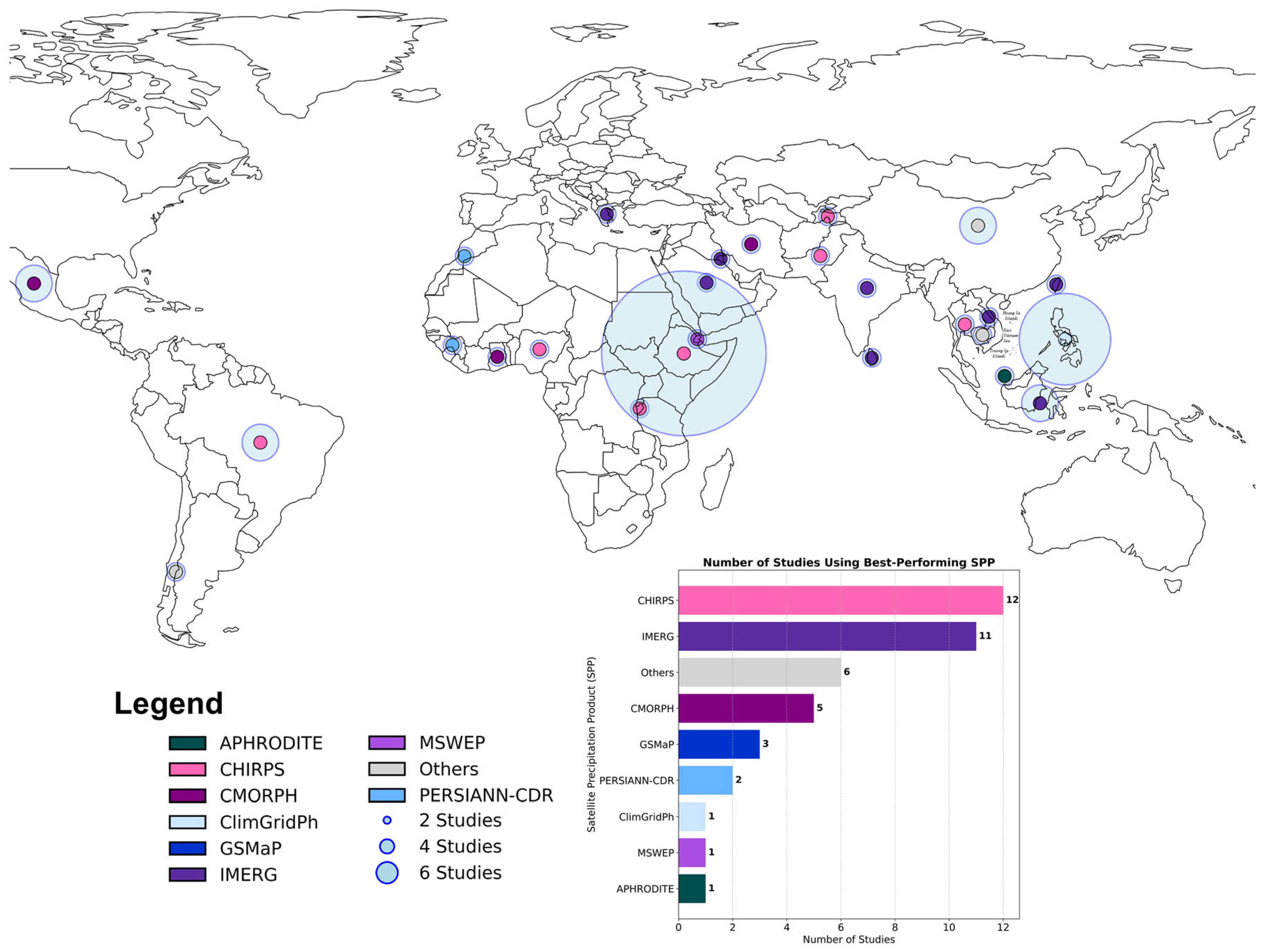
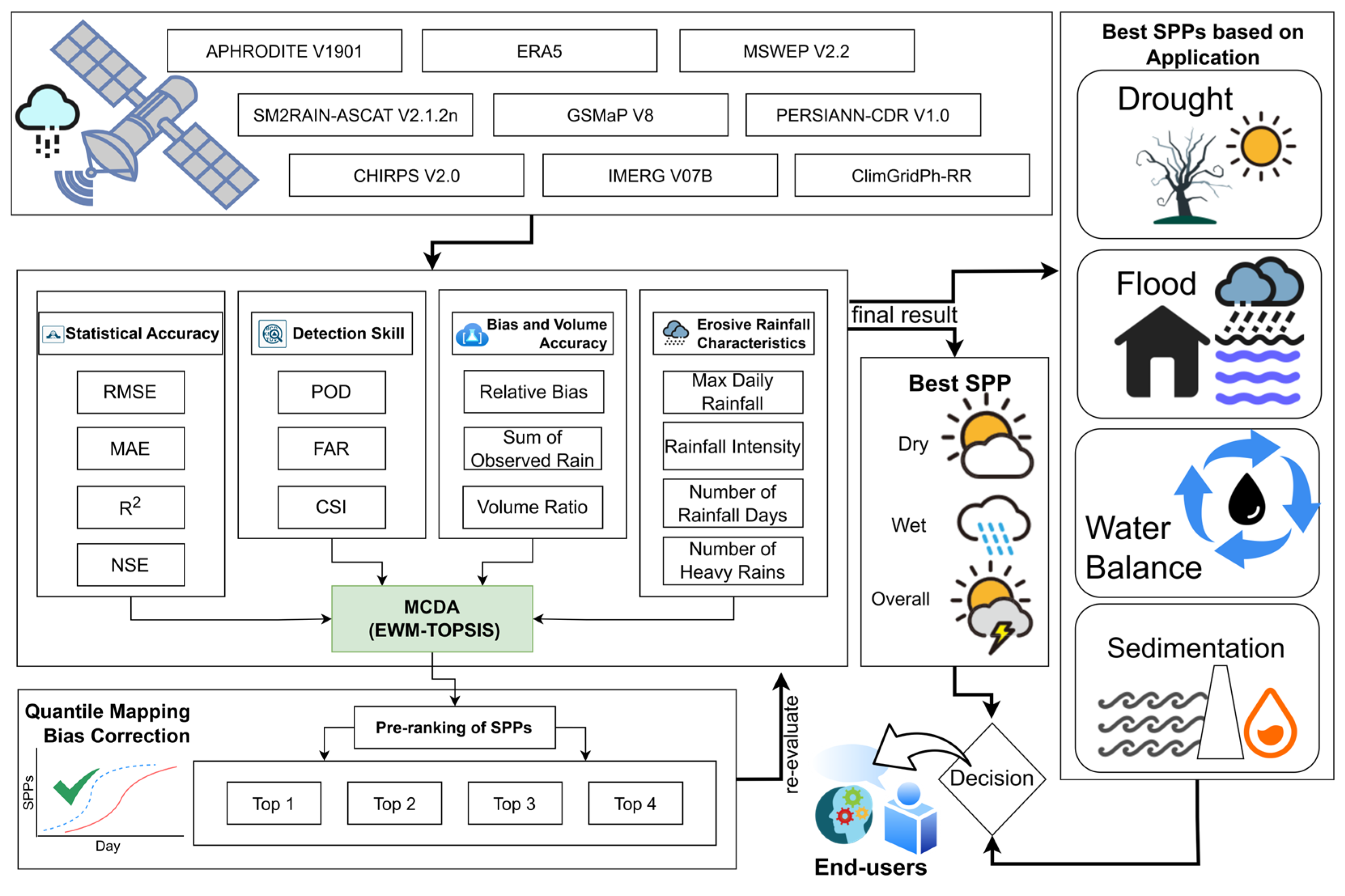
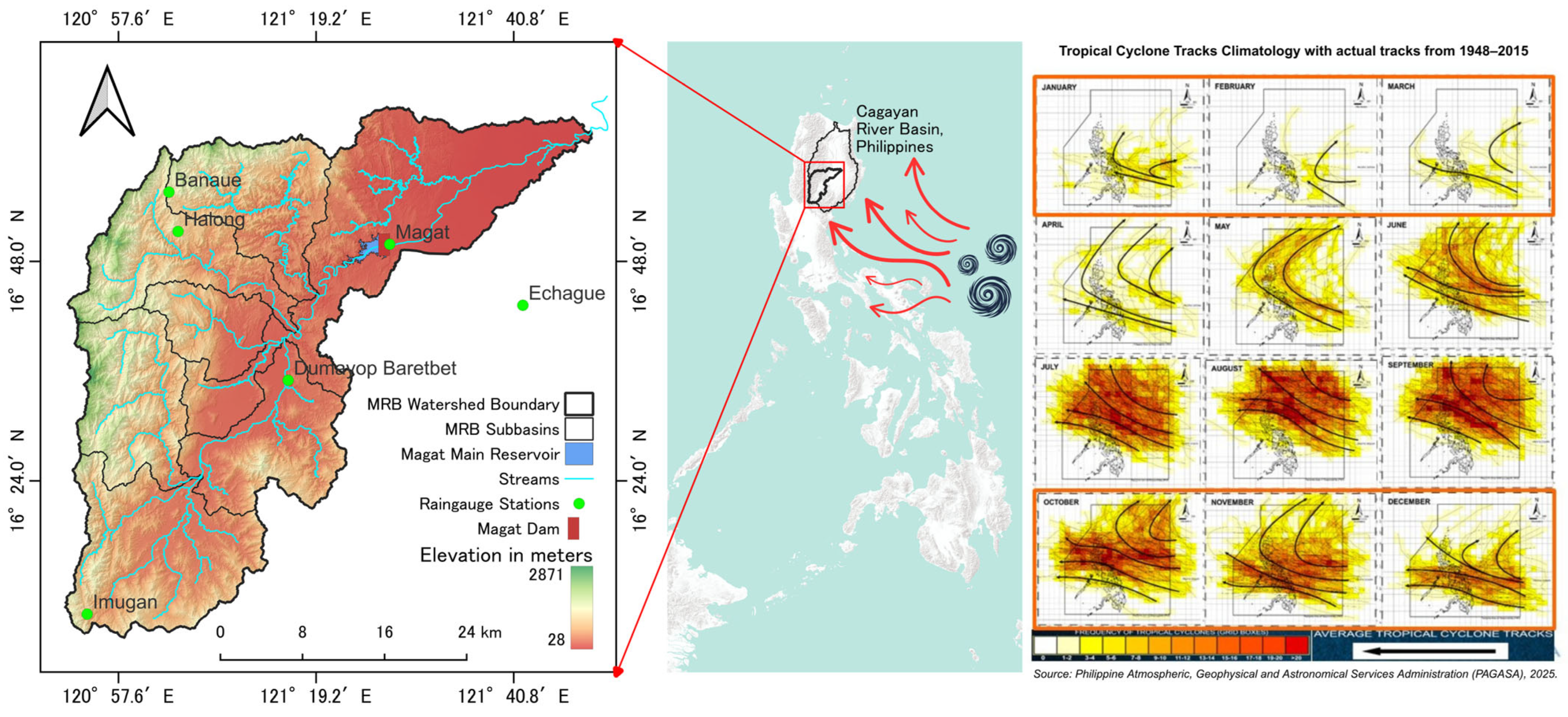

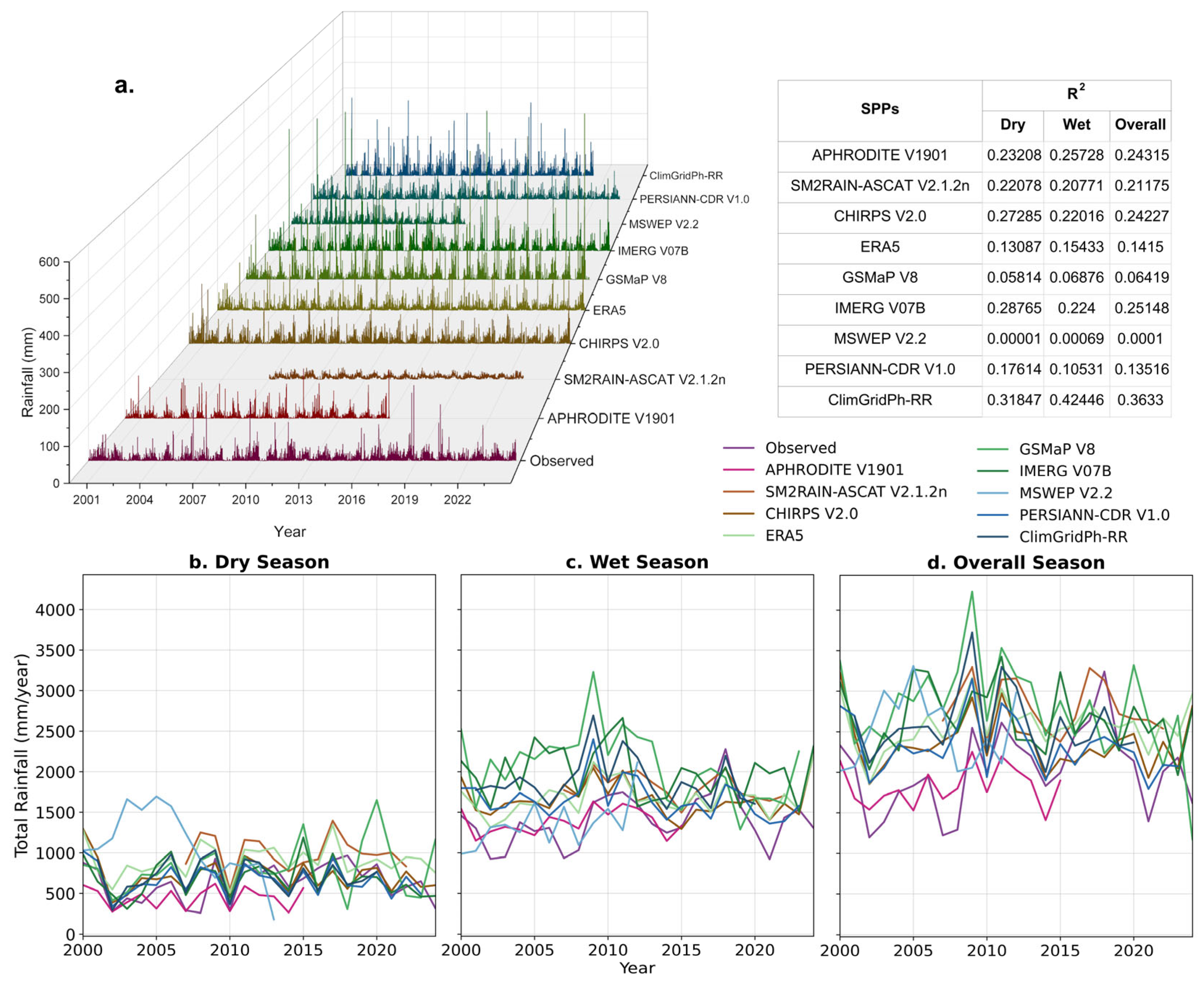
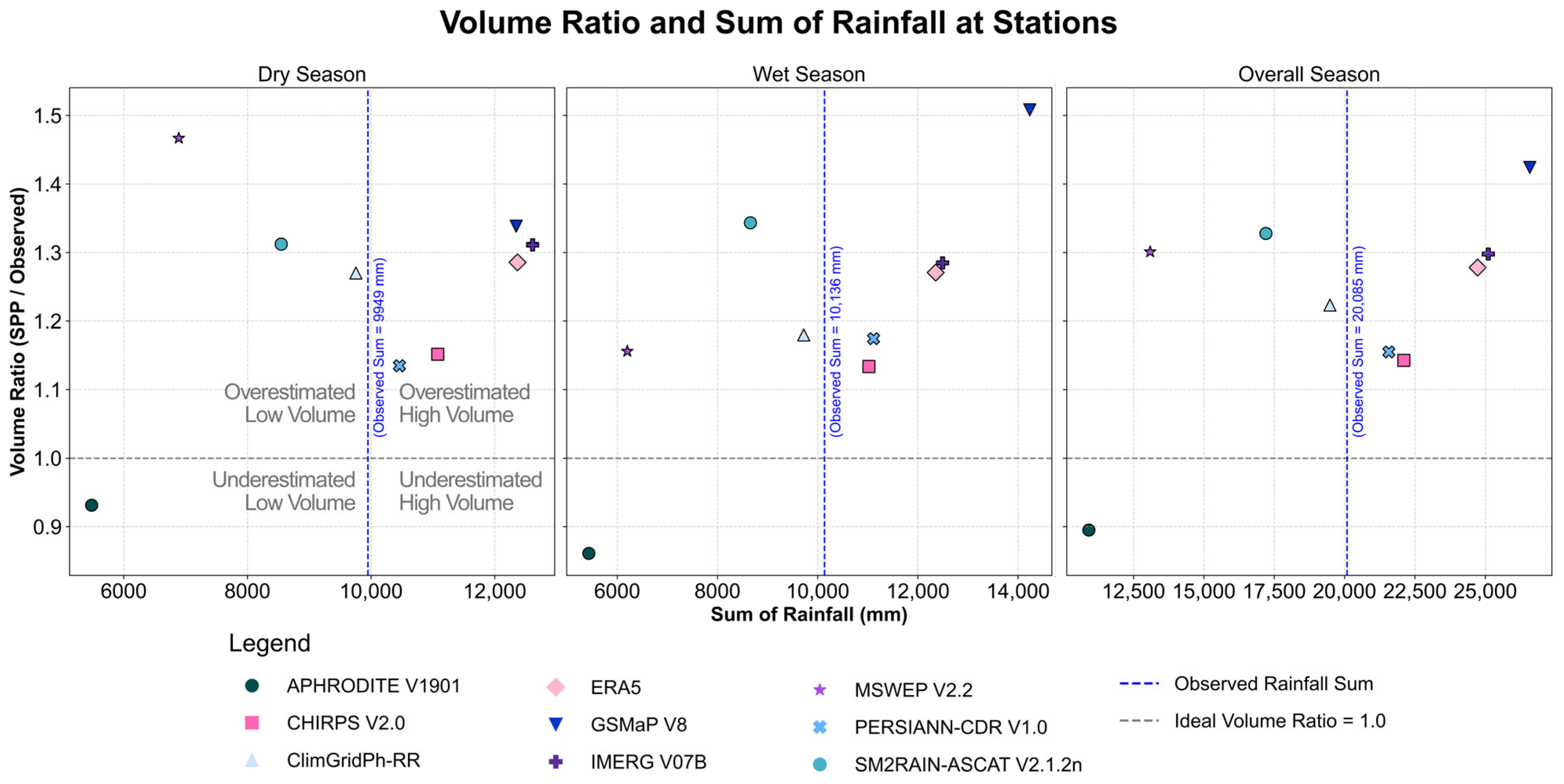
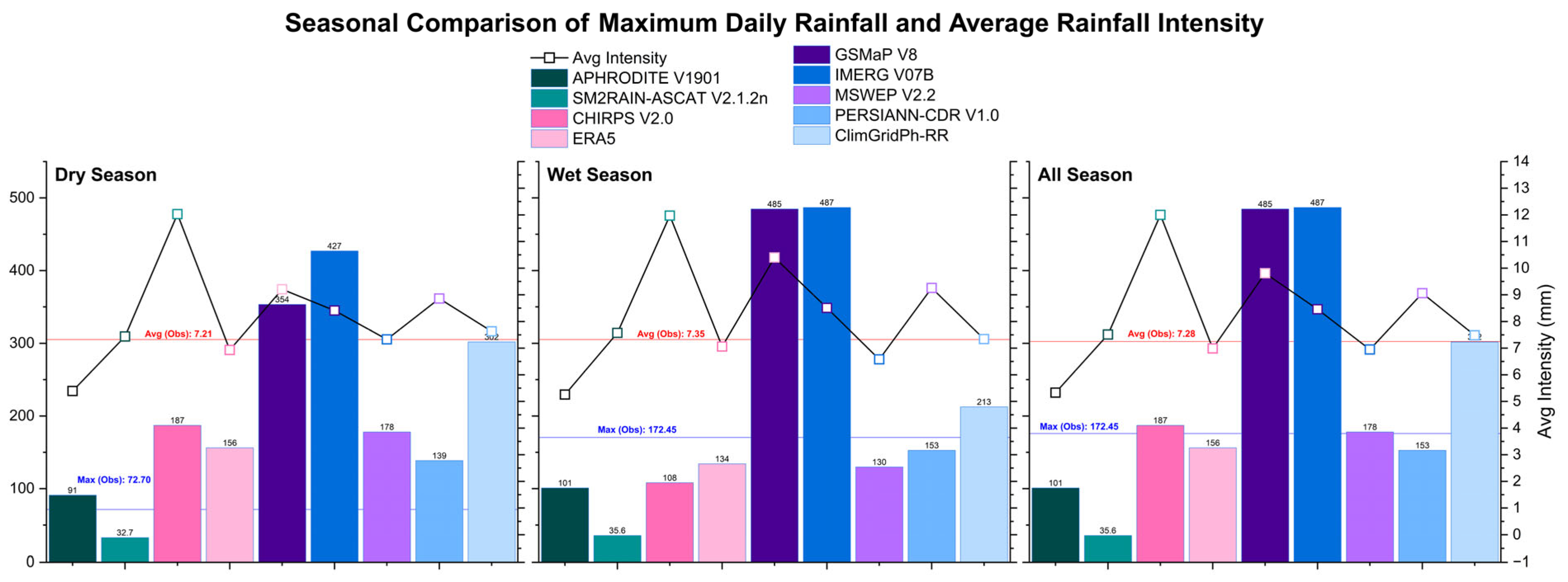
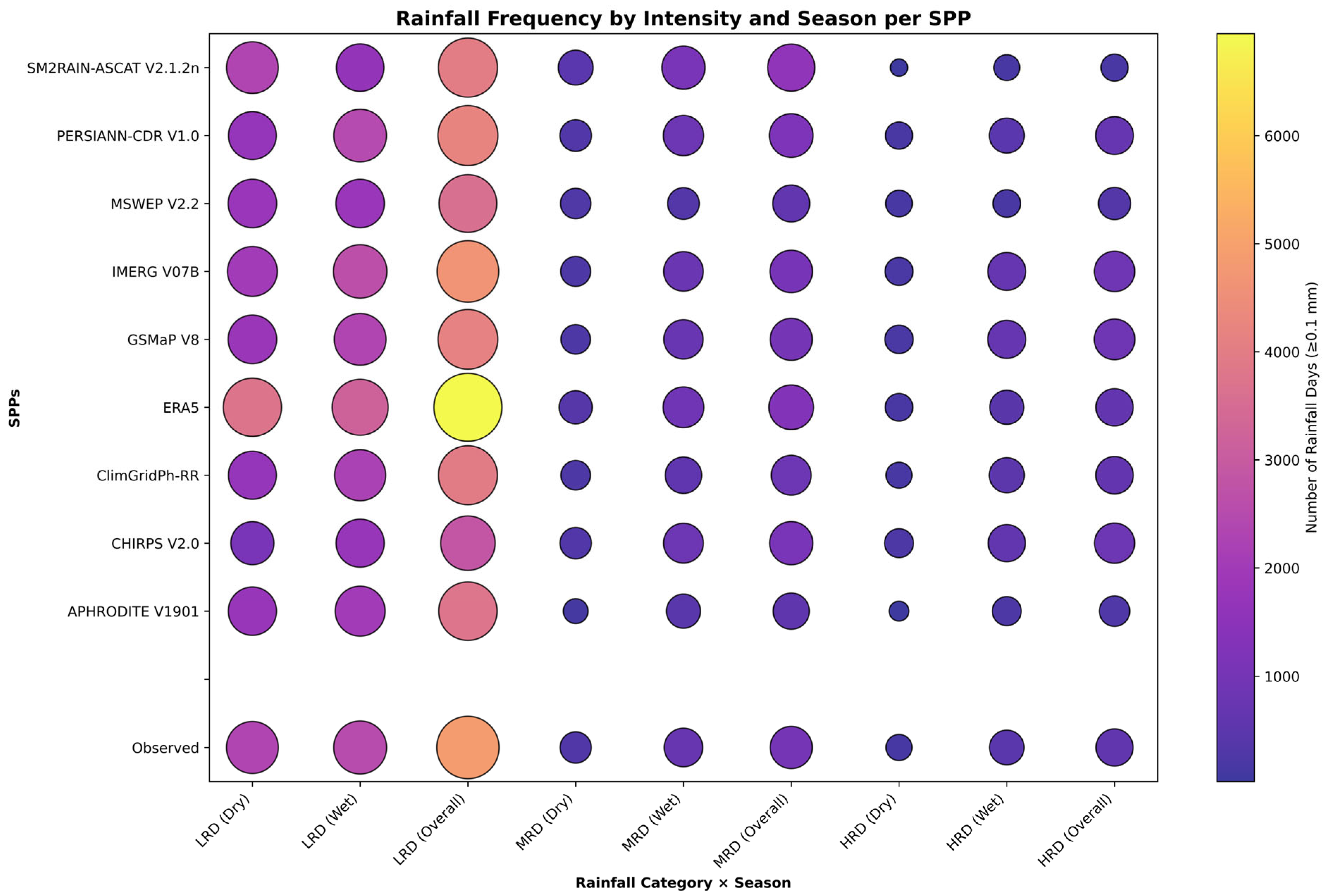

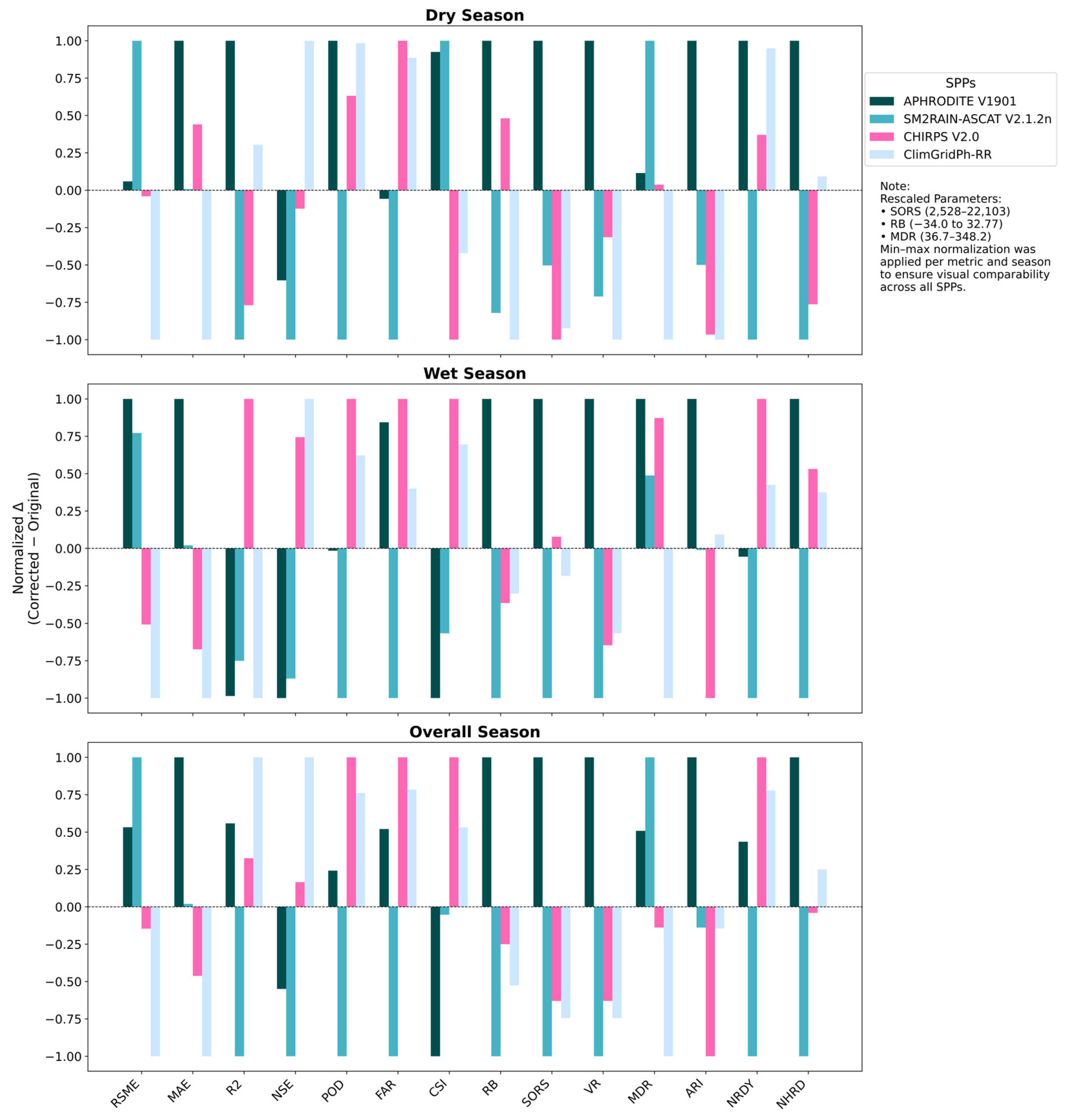
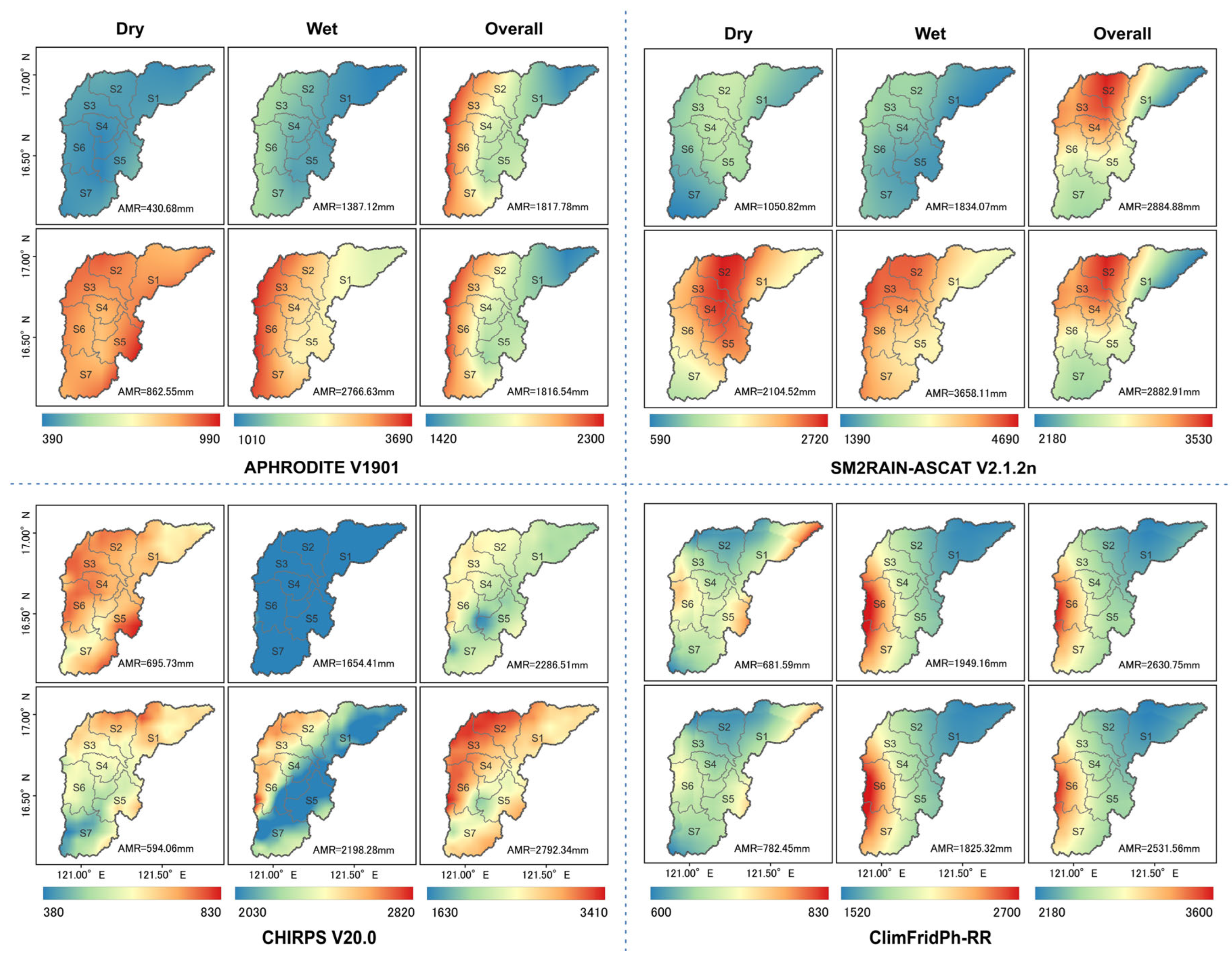
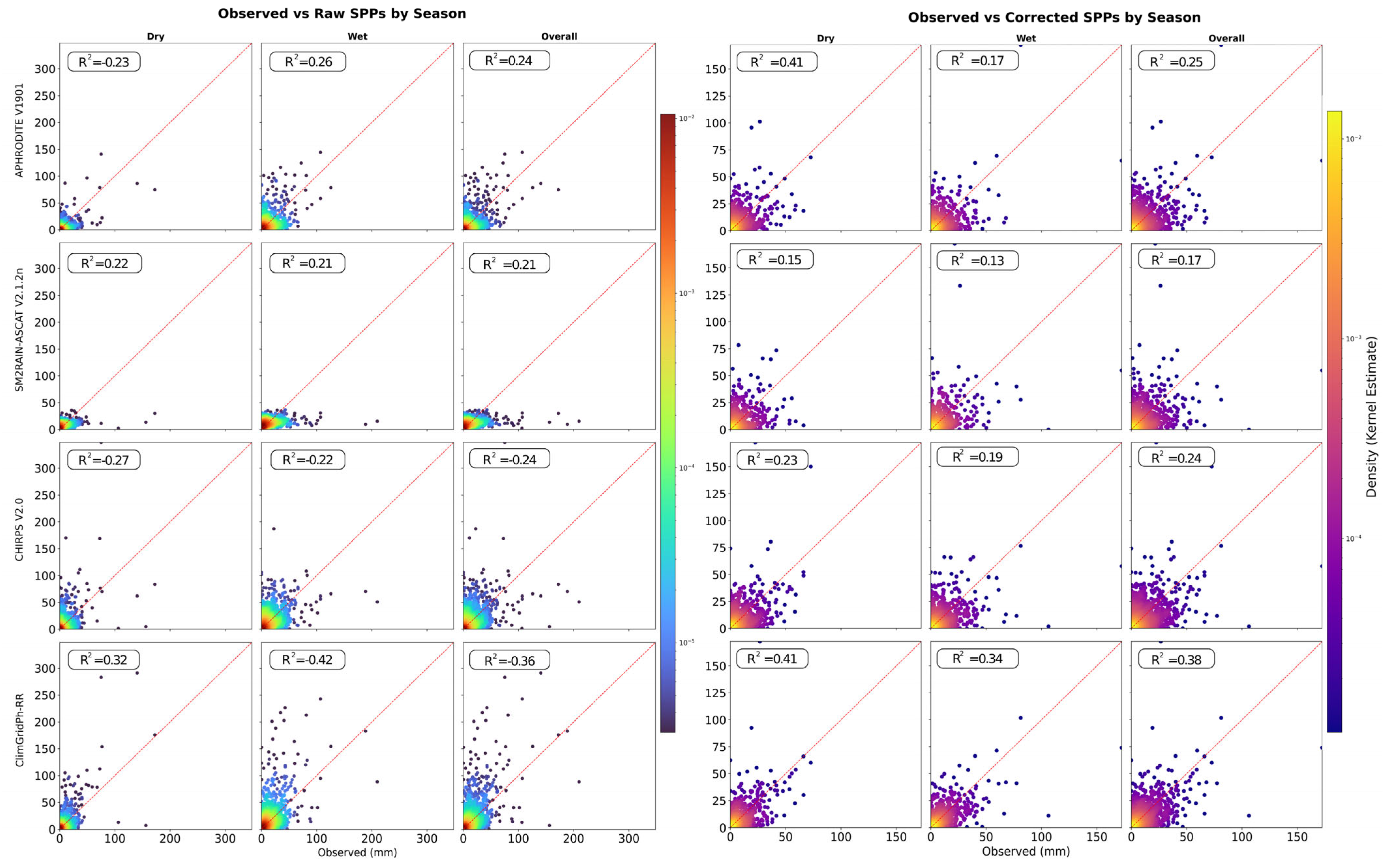

| SPP | Temporal Coverage | Resolution (Spatial and Temporal) | Spatial Coverage | Latency | Category | References |
|---|---|---|---|---|---|---|
| APHRODITE V1901 | 1951–2025 (2000–2015 used) | 0.25°/Daily | 60°N–60°S | N/A (Historical) | Gauge-based | [50] |
| ERA5 | 2000–2024 | 0.1°/Hourly | Global | ~5 days | Reanalysis | [51] |
| MSWEP V2.2 | 2000–2013 | 0.1°/3-hourly | 60°N–60°S | Several days | Merged | [52] |
| SM2RAI-ASCAT V2.1.2n | 2007–2022 | 0.125°/Daily | 60°N–60°S (land) | Historical (offline) | Satellite-only | [53] |
| GSMaP V8 | 2000–2024 | 0.1°/Hourly | 60°N–60°S | 12–24 h | Satellite-only | [54] |
| PERSIANN°CDR V1.0 | 1983–present (2000–2024 used) | 0.25°/Daily | 60°N–60°S | ~6–12 months | Merged | [55] |
| CHIRPS V2.0 | 2000–2024 | 0.05°/Daily | 50°N–50°S | ~24 h | Merged | [56] |
| IMERG V07B (Final Run) | 2000–2024 | 0.1°/30 min | 65°N–65°S | ~3 months | Merged | [57] |
| ClimGridPh-RR | 2001–2020 | 0.01°Daily | Philippines | Few months | Merged | [15] |
| Group | Metric | Formula and Criteria | Ideal Value | Purpose/ Interpretation |
|---|---|---|---|---|
| Statistical Accuracy | RMSE | 0 | Measures the average magnitude of the error. | |
| MAE | 0 | Measures the average absolute difference. | ||
| R2 | 1 | Indicates the strength and direction of a linear relationship. | ||
| NSE | Criterion: ≥0.8 (VG), ≥0.7 (G), ≥0.5 (S) | 1 | Indicates predictive power of SPP vs. observations. | |
| Detection Skill | POD | D11—Number of times both satellite and rain gauge detected precipitation (i.e., hits) D01—Number of times the rain gauge detected precipitation, but the satellite did not (i.e., misses) | 1 | Measures how well precipitation events are detected. |
| FAR | D10—Number of times the satellite detected precipitation, but the rain gauge did not (false alarms) | 1 | Measures frequency of false detections. | |
| CSI | 1 | Balances hits, misses, and false alarms. | ||
| Bias and Volume Accuracy | RB | 0 | Measures under- or overestimation in total precipitation. | |
| SORS | Total precipitation observed (used for bias and volume comparisons). | |||
| VR | 1 | The ratio of estimated to observed total precipitation. | ||
| Erosive Precipitation Characteristics | MDR | — | Highest daily precipitation—relevant for flood and erosion. | |
| ARI | Pi—Daily precipitation on a day, where Pi > 0 Pi—Number of rainy days (i.e., days with precipitation > 0 mm) | — | Average intensity of precipitation during events. | |
| NRDY | — | Days with any measurable precipitation. | ||
| NHRD | — | Days with heavy precipitation linked to flood/sediment risk. |
| Application | Performance Parameter | Justification/Basis |
|---|---|---|
| Drought | RB | Detects systematic over- or underestimation in dry conditions |
| NRDY | Captures precipitation frequency critical for drought detection | |
| VR | Measures agreement in total precipitation volume | |
| MAE | Reflects the general accuracy of estimation | |
| R2 | Temporal consistency and seasonality agreement | |
| NSE | Predictive skill in modeling low flow thresholds (drought onset) | |
| NHRD | Detects missed high-intensity events that affect agricultural drought resilience | |
| Flood | MDR | Key driver for peak flows and flood simulation |
| POD | Ability to capture actual heavy precipitation events | |
| FAR | Avoidance of false flood warnings | |
| CSI | Combined skill measure of detection and false alarm trade-off | |
| NSE | Overall predictive power for extreme flows | |
| RMSE | Penalizes larger errors (important for extremes) | |
| R2 | Captures seasonal flood timing alignment | |
| NHRD | High rainfall counts contribute to threshold exceedance | |
| Water Balance | VR | Reflects catchment water input estimation accuracy |
| SORS | Total baseline volume for comparison | |
| MAE | Affects soil moisture and baseflow estimation | |
| RMSE | Penalizes deviations in total water input | |
| R2 | Interannual and seasonal flow representation | |
| NSE | Hydrologic performance proxy in water yield modeling | |
| POD | Needed to reflect daily water input detection | |
| Sedimentation | NHRD | Indicator of erosive precipitation (R-factor component) |
| ARI | Drives detachment and sediment transport | |
| MDR | Captures high-intensity events linked to mass erosion | |
| RB | Affects long-term erosion and deposition estimates | |
| VR | Overestimation of volume can inflate erosion risk predictions | |
| RSME | Large over/underestimates distort suspended sediment transport | |
| CSI | Captures correct event-type distributions linked to sediment bursts |
| Metrics | Season | APHRO -DITE V1901 | SM2RAIN-ASCAT V2.1.2n | CHIRPS V2.0 | ERA5 | GSMaP V8 | IMERG V07B | MSWEP V2.2 | PERSI -ANN -CDR V1.0 | Clim -GridPh-RR |
|---|---|---|---|---|---|---|---|---|---|---|
| Dry | 9.03 | 7.93 | 10.99 | 10.28 | 9.80 | 15.16 | 16.32 | 11.30 | 13.56 | |
| RSME | Wet | 9.57 | 9.69 | 11.27 | 11.40 | 11.07 | 16.53 | 14.89 | 12.58 | 11.19 |
| Overall | 9.30 | 8.86 | 11.13 | 10.86 | 10.45 | 15.86 | 15.62 | 11.96 | 12.43 | |
| Dry | 4.66 | 5.51 | 5.63 | 5.70 | 7.29 | 5.59 | 8.69 | 5.93 | 5.37 | |
| MAE | Wet | 5.06 | 5.84 | 5.86 | 5.82 | 8.27 | 5.58 | 8.16 | 6.53 | 5.20 |
| Overall | 4.86 | 5.68 | 5.74 | 5.76 | 7.78 | 5.58 | 8.43 | 6.23 | 5.29 | |
| Dry | 0.23 | 0.22 | 0.27 | 0.13 | 0.06 | 0.29 | 0.00 | 0.18 | 0.32 | |
| R2 | Wet | 0.26 | 0.21 | 0.22 | 0.15 | 0.07 | 0.22 | 0.00 | 0.11 | 0.42 |
| Overall | 0.24 | 0.21 | 0.24 | 0.14 | 0.06 | 0.25 | 0.00 | 0.14 | 0.36 | |
| Dry | −0.04 | 0.15 | −0.58 | −0.74 | −3.89 | −2.00 | −2.24 | −0.71 | −1.39 | |
| NSE | Wet | 0.15 | 0.17 | −0.26 | −0.31 | −3.80 | −1.72 | −0.84 | −0.56 | −0.11 |
| Overall | 0.07 | 0.16 | −0.40 | −0.49 | −3.84 | −1.84 | −1.40 | −0.62 | −0.63 | |
| Dry | 0.89 | 1.00 | 0.63 | 1.00 | 0.76 | 0.82 | 0.95 | 0.76 | 0.82 | |
| POD | Wet | 0.88 | 1.00 | 0.63 | 0.99 | 0.77 | 0.81 | 0.96 | 0.77 | 0.82 |
| Overall | 0.89 | 1.00 | 0.63 | 1.00 | 0.77 | 0.82 | 0.95 | 0.76 | 0.82 | |
| Dry | 0.21 | 0.25 | 0.15 | 0.27 | 0.20 | 0.17 | 0.33 | 0.21 | 0.20 | |
| FAR | Wet | 0.23 | 0.28 | 0.16 | 0.29 | 0.22 | 0.19 | 0.32 | 0.21 | 0.23 |
| Overall | 0.22 | 0.27 | 0.15 | 0.28 | 0.21 | 0.18 | 0.32 | 0.21 | 0.21 | |
| Dry | 0.72 | 0.75 | 0.57 | 0.73 | 0.64 | 0.70 | 0.65 | 0.63 | 0.68 | |
| CSI | Wet | 0.70 | 0.72 | 0.56 | 0.71 | 0.64 | 0.68 | 0.66 | 0.64 | 0.66 |
| Overall | 0.71 | 0.73 | 0.57 | 0.72 | 0.64 | 0.69 | 0.65 | 0.63 | 0.67 | |
| Dry | −6.85 | 31.22 | 15.16 | 28.57 | 33.84 | 31.10 | 46.69 | 13.49 | 27.00 | |
| RB | Wet | −13.89 | 34.34 | 13.37 | 27.07 | 50.81 | 28.49 | 15.59 | 17.45 | 17.98 |
| Overall | −10.49 | 32.77 | 14.26 | 27.81 | 42.42 | 29.79 | 30.11 | 15.50 | 22.33 |
| Metric | Entropy (Ej) | Diversification (Dj) | Weight (Wj) |
|---|---|---|---|
| RSME | 0.023 | 0.977 | 0.085 |
| MAE | 0.003 | 0.997 | 0.087 |
| R2 | 0.001 | 0.999 | 0.087 |
| NSE | 0.011 | 0.989 | 0.086 |
| POD | 0.296 | 0.704 | 0.061 |
| FAR | 0.438 | 0.562 | 0.049 |
| CSI | 1.000 | 0.010 | 0.001 |
| RB | 0.010 | 0.990 | 0.086 |
| SORS | 0.003 | 0.997 | 0.087 |
| VR | 0.001 | 0.999 | 0.087 |
| MDR | 0.062 | 0.938 | 0.081 |
| ARI | 0.018 | 0.982 | 0.085 |
| NRDY | 0.625 | 0.375 | 0.033 |
| NHRD | 0.004 | 0.996 | 0.087 |
| Metrics | Season | APHRODITE V1901 | SM2RAIN-ASCAT V2.1.2n | CHIRPS V2.0 | ClimGridPh -RR | Ideal/ Observed Value |
|---|---|---|---|---|---|---|
| Dry | 6.36 | 9.17 | 7.92 | 6.50 | 0 | |
| RSME | Wet | 12.15 | 11.84 | 10.99 | 9.99 | 0 |
| Overall | 9.70 | 10.59 | 9.57 | 8.43 | 0 | |
| Dry | 2.67 | 3.29 | 3.51 | 2.91 | 0 | |
| MAE | Wet | 7.63 | 7.48 | 6.83 | 5.86 | 0 |
| Overall | 5.15 | 5.38 | 5.16 | 4.39 | 0 | |
| Dry | 0.41 | 0.15 | 0.23 | 0.41 | 1 | |
| R2 | Wet | 0.17 | 0.13 | 0.19 | 0.34 | 1 |
| Overall | 0.25 | 0.17 | 0.24 | 0.38 | 1 | |
| Dry | −0.01 | −0.25 | −0.02 | 0.39 | 1 | |
| NSE | Wet | −0.35 | −0.28 | −0.14 | 0.10 | 1 |
| Overall | −0.01 | −0.20 | −0.03 | 0.25 | 1 | |
| Dry | 0.67 | 0.68 | 0.39 | 0.60 | 1 | |
| POD | Wet | 0.93 | 0.93 | 0.80 | 0.95 | 1 |
| Overall | 0.82 | 0.82 | 0.63 | 0.80 | 1 | |
| Dry | 0.23 | 0.19 | 0.25 | 0.29 | 0 | |
| FAR | Wet | 0.17 | 0.12 | 0.11 | 0.15 | 0 |
| Overall | 0.19 | 0.15 | 0.15 | 0.20 | 0 | |
| Dry | 0.56 | 0.59 | 0.35 | 0.48 | 1 | |
| CSI | Wet | 0.78 | 0.82 | 0.73 | 0.81 | 1 |
| Overall | 0.69 | 0.72 | 0.56 | 0.67 | 1 | |
| Dry | −30.62 | −19.86 | −16.39 | −26.75 | 0 | |
| RB | Wet | 17.58 | 4.21 | 2.77 | 9.34 | 0 |
| Overall | 3.17 | −2.83 | −2.87 | −1.59 | 0 | |
| Dry | 2528.42 | 3037.60 | 5004.51 | 3532.55 | 5696.774 | |
| SORS | Wet | 10,046.95 | 9551.98 | 14,332.95 | 12,134.29 | 13,647.21 |
| Overall | 12,575.37 | 12,589.58 | 19,337.46 | 15,666.84 | 19,343.98 | |
| Dry | 0.44 | 0.53 | 0.88 | 0.62 | 1 | |
| VR | Wet | 0.74 | 0.70 | 1.05 | 0.89 | 1 |
| Overall | 0.65 | 0.65 | 1.00 | 0.81 | 1 | |
| Dry | 68.08 | 172.45 | 150.05 | 74.09 | 172.45 | |
| MDR | Wet | 172.45 | 78.40 | 172.45 | 172.45 | 81.22 |
| Overall | 172.45 | 172.45 | 172.45 | 172.45 | 172.45 | |
| Dry | 3.84 | 4.57 | 8.75 | 4.32 | 4.92 | |
| ARI | Wet | 9.49 | 9.07 | 10.80 | 9.12 | 9.1 |
| Overall | 7.32 | 7.33 | 10.18 | 7.29 | 7.28 | |
| Dry | 600.00 | 608.00 | 572.00 | 740.00 | 1068 | |
| NRDY | Wet | 1030.00 | 1022.00 | 1327.00 | 1298.00 | 1456 |
| Overall | 1630.00 | 1630.00 | 1899.00 | 2038.00 | 2524 | |
| Dry | 63.00 | 74.00 | 135.00 | 99.00 | 152 | |
| NHRD | Wet | 346.00 | 334.00 | 507.00 | 412.00 | 481 |
| Overall | 409.00 | 408.00 | 642.00 | 511.00 | 633 |
| Metrics | Seasonal (wj) in % | Application (wj) in % | ||||||
|---|---|---|---|---|---|---|---|---|
| Dry | Wet | Overall | Overall (Raw) | Drought | Flood | Water Balance | Sedimentation | |
| RSME | 14.81 | 20.9 | 16.67 | 8.5 | 15.29 | 14.28 | 19.04 | |
| MAE | 17.62 | 24.13 | 24.65 | 8.7 | 18.26 | 14.29 | ||
| R2 | 3.51 | 2.78 | 1.93 | 8.7 | 18.27 | 15.56 | 14.29 | |
| NSE | 17.85 | 20.9 | 17.95 | 8.6 | 18.29 | 15.6 | 14.29 | |
| POD | 0.92 | 0.09 | 0.26 | 6.1 | 15.32 | 14.28 | ||
| FAR | 15.42 | 14.14 | 22.12 | 4.9 | 15.68 | |||
| CSI | 0.82 | 0.05 | 0.18 | 0.1 | 15.3 | 19.14 | ||
| RB | 18.02 | 13.12 | 13.2 | 8.6 | 17.75 | 17.81 | ||
| SORS | 1.43 | 0.55 | 0.75 | 8.7 | 14.29 | |||
| VR | 1.43 | 0.55 | 0.75 | 8.7 | 18.18 | 14.28 | 19.09 | |
| MDR | 3.44 | 1.78 | 0 | 8.1 | 0.65 | 0.92 | ||
| ARI | 2.64 | 1.11 | 0.51 | 8.5 | 16.47 | |||
| NRDY | 0.22 | 0.31 | 0.22 | 3.3 | 8.28 | |||
| NHRD | 1.88 | 0.6 | 0.83 | 8.7 | 0.97 | 6.53 | 7.53 | |
Disclaimer/Publisher’s Note: The statements, opinions and data contained in all publications are solely those of the individual author(s) and contributor(s) and not of MDPI and/or the editor(s). MDPI and/or the editor(s) disclaim responsibility for any injury to people or property resulting from any ideas, methods, instructions or products referred to in the content. |
© 2025 by the authors. Licensee MDPI, Basel, Switzerland. This article is an open access article distributed under the terms and conditions of the Creative Commons Attribution (CC BY) license (https://creativecommons.org/licenses/by/4.0/).
Share and Cite
Gacu, J.G.; Kantoush, S.A.; Nguyen, B.Q. Full-Cycle Evaluation of Multi-Source Precipitation Products for Hydrological Applications in the Magat River Basin, Philippines. Remote Sens. 2025, 17, 3375. https://doi.org/10.3390/rs17193375
Gacu JG, Kantoush SA, Nguyen BQ. Full-Cycle Evaluation of Multi-Source Precipitation Products for Hydrological Applications in the Magat River Basin, Philippines. Remote Sensing. 2025; 17(19):3375. https://doi.org/10.3390/rs17193375
Chicago/Turabian StyleGacu, Jerome G., Sameh Ahmed Kantoush, and Binh Quang Nguyen. 2025. "Full-Cycle Evaluation of Multi-Source Precipitation Products for Hydrological Applications in the Magat River Basin, Philippines" Remote Sensing 17, no. 19: 3375. https://doi.org/10.3390/rs17193375
APA StyleGacu, J. G., Kantoush, S. A., & Nguyen, B. Q. (2025). Full-Cycle Evaluation of Multi-Source Precipitation Products for Hydrological Applications in the Magat River Basin, Philippines. Remote Sensing, 17(19), 3375. https://doi.org/10.3390/rs17193375









